Now & New
- Experience
Destined Return of Toukasan: Back to Its Former Self
Ever since the end of the COVID-19 pandemic—no, even during the State of Emergency and the intermittent “Quasi-states of Emergency”—we residents of Hiroshima had long dreamt of the year where all of our traditional festivals would make a comeback in a state that preceded the global epidemiological crisis. In March this year, that dream made one giant leap toward becoming a reality as Japan relaxed its stance on the wearing of masks in public, and the measures to prevent the spread of infection such as designated bottles of hand sanitizer at store entrances or the deliberate blocking off of adjacent seats in eateries began disappearing. Following Golden Week and the G7 Summit in May, Toukasan woke from its slumber and kicked off summer as the first major festival in Hiroshima City held without any COVID-19 restrictions.
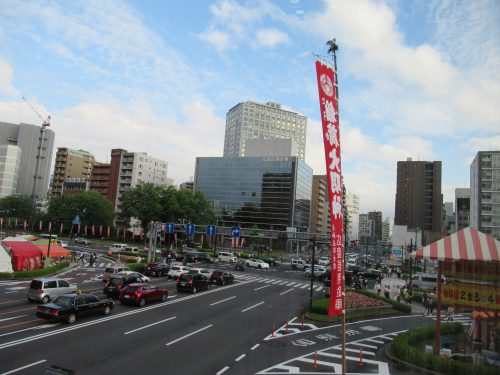
Sure, there were lots of food stands and performances on stage last year, but the number of attractions went up, the long-anticipated Bon dance made a comeback, and any masking seen at the festival site was completely voluntary. As the cherry on top of the proverbial sundae, it was day after day of sunshine for the whole weekend, which intensified the desire for folks to stroll the city in yukata. This year’s Toukasan was held from the 2nd to the 4th of June, and since I was eager to see this revitalized festival for myself, I made my way downtown right after work on Friday.
Scouting the Site
As per my private tradition, the first day of Toukasan was spent solely on reconnaissance. Friday afternoon sees fewer visitors as tons of people are still at work (including my own friends), so I walk the streets of downtown Hiroshima to take optimal photos of the festival site and scout out points of interest. When it comes to taking pictures of the Toukasan shrine itself, instead of approaching the shrine grounds, I advise entering a hotel across from the shrine and going up to the second floor or higher (if permitted) to snag a picture-perfect view from a window, just like this.
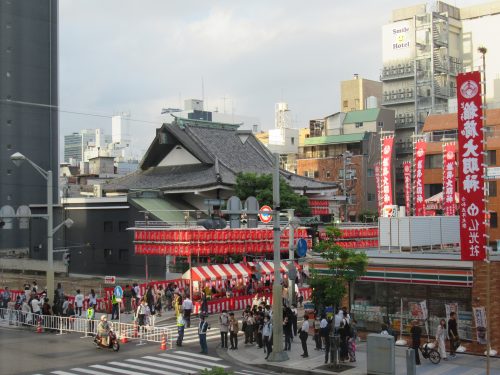
As can be seen from the above photo, there was no meager amount of people even on a weekday, and that number only increased as students gradually got out of school and entire families started swinging by the shrine and festival stands. These stands were lined up along Chuo-dori from the intersection with Aioi Boulevard (the main streetcar street) down south to Peace Boulevard, stretched west along Peace Boulevard to Crystal Plaza, and infiltrated Alice Garden, Kinzagai, and the southern perimeter of Parco. As far as food and beverages were concerned, there was an overwhelmingly diverse array of products in every color of the rainbow, but Toukasan in 2023 saw a lot more non-food stands set up than it did in 2022. In addition to the more numerous character mask shops and carnival games, the classic haunted house made a reappearance to scare the kiddos (and grown-ups with inner children) in a world without the monstruous virus. Although I’m not one to enjoy a haunted house on my own, there was a food stand or two that piqued my interest, but I would save the gastronomic gauntlet for the next morning after finishing my prayer at the Toukasan shrine.
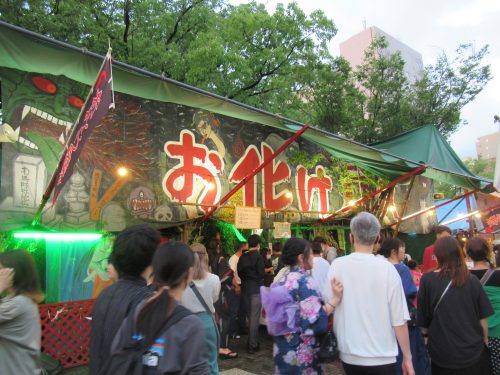
Saturday Service
The Toukasan festivities began at 10:00 on all three days, and I utilized Saturday morning to tackle the points of interest before the floodgates of visitors opened in the afternoon and evening. Before seeing anything else, I made a beeline for the shrine, and as expected, lines—albeit relatively short—had already formed. Japanese people on average tend not to be fervently religious, but on certain shrine-centered festivals like Toukasan, the locals converge on the shrine in question like it’s some sort of pilgrimage, and that habit has rubbed off on me as well.

Paying no heed to the number of people waiting, I casually inserted myself into the line and waited for my turn to pray. Since the altar was wide, multiple visitors could pray simultaneously, and the line progressed faster than I thought it would. I got my trusty ¥5 coin ready while in line and before I knew it, I was up there, tossed my coin into the alms box, and clasped my hands together to voice my desires to the patron deity. Given how tough the past few years have been on most of us in Japan and all over the world, I prayed for even better times ahead as this country makes an ever-accelerating recovery.
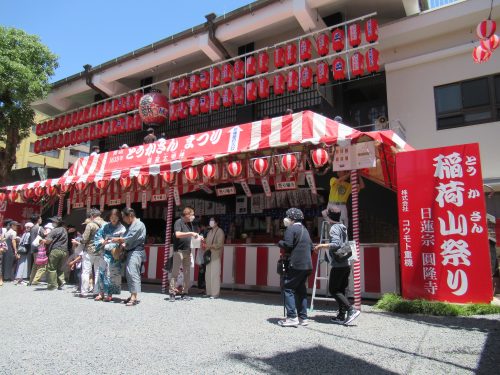
Moment of Joy: The Missing Piece
After finishing my prayer, I made my way north past some food stands up to Shintenchi Park, where the evening festivities would be concentrated. Obviously, since it was still before noon, the park was empty and almost nobody was there, but simply seeing the yagura (temporary scaffold assembled specifically for Obon events) mentally took me back to 2019, the last time I got to dance here.

The refreshment tents were closed but covered with posters announcing the appearance of Issei Minami, the man who sang at this spot in years past and also performed at last year’s Bon Dance Festival in Ujina. Knowing that the missing link of Toukasan had finally returned after a four-year hiatus pumped me up to see Shintenchi Park thrive at night later on.
Trial and Error
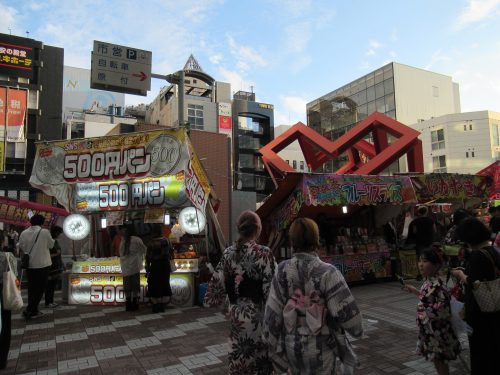
As the clock inched closer to noon, my tummy began to respond audibly, so I backtracked to some of the food stands that caught my attention the evening prior. Around Parco were the usual festival food heavy-hitters like grilled squid, shaved ice, yakisoba, and candied fruit, but I usually like to go for something I have yet to try. Tempting as it was to get myself something cool or frozen on this hot, sunny day, I had to get myself a real meal, so I gravitated toward a stand selling Hiroshima-style okonomiyaki. I was in the vicinity of Okonomi Village and could have simply had one upstairs, but the okonomiyaki here was only ¥500 and I insisted on trying Hiroshima-style okonomiyaki from a stand, which has recently gained traction at festivals nationwide, even as far north as Hokkaido!
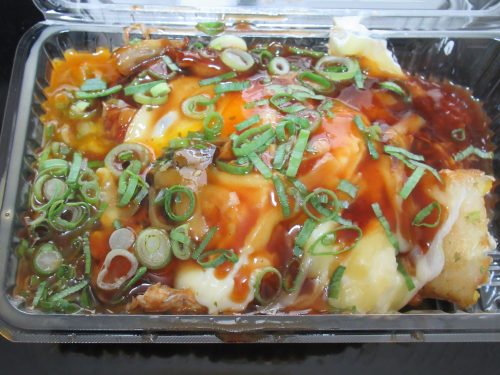
I know what you’re thinking: it doesn’t look so appetizing stuffed into a box like this, but never judge an okonomiyaki by the dish on which it is served. Unfortunately, due to space constraints, this Hiroshima-style okonomiyaki contained few to no soba noodles, but at least the classic pancake base, egg, red pickled ginger, belly pork, green onions, bonito flakes, and mayonnaise were present in ample amounts. The plastic box was rather hot and starting to warp from the food inside, so in order to have an easier time eating it, I took it back to my place to enjoy it properly seated at a table. By the time I was finished with it, my thoughts were: I don’t regret buying one to try, but don’t ask me to buy another festival okonomiyaki.
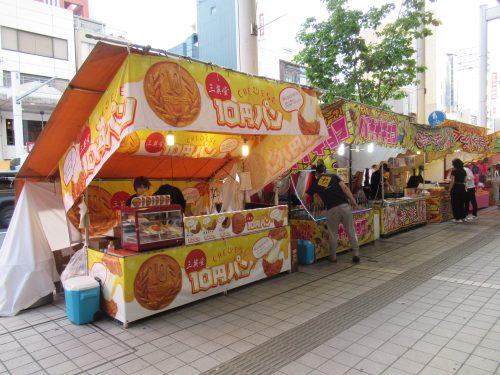
The second item I wanted to try was the coin-shaped filled bread, which apparently has been blowing up on social media. As pictured above, these piping hot snacks are available in denominations of ¥10, ¥500, and even ₩500, and can be filled with stuff like chocolate, custard cream, mozzarella cheese, azuki beans, or a combination of the above. My original version of choice was a ₩500 coin filled with cheese and red beans, but as that was sold out, I instead went for a ¥10 variety filled with mozzarella only. Once again, I took my food home to enjoy in privacy and comfort.

One popular way to share this snack on social media is to post a video pulling apart the bread with one’s hands or mouth to see how far the cheese would stretch, which I too attempted. However, it took me a while to get home and to snap a good photo of me stretching the cheese (most people doing this have a friend to film them; I didn’t), so the stretched cheese ended up cooling and looking like a singular glob. This one at least tasted good despite having gotten a bit cold, so I’ll definitely try it again, but if I do, I’ll forego the photo and just keep the stretchy moments to myself.
The Last Dance
After finishing my festival lunch, I waited out the sweltering heat in my room until dusk, at which point, I headed out once again in the direction of Shintenchi Park. The place was the same, but the atmosphere was a world apart as Chuo-dori turned into a Pedestrian Heaven—that is, a vehicle-free zone so clogged with foot traffic that the police had to be summoned (they always are, no biggie) and barriers had to be put up to enforce order. Seeing the sheer number of people around the shrine and on the streets was daunting even when I was on the other side, waiting for the light to turn green.
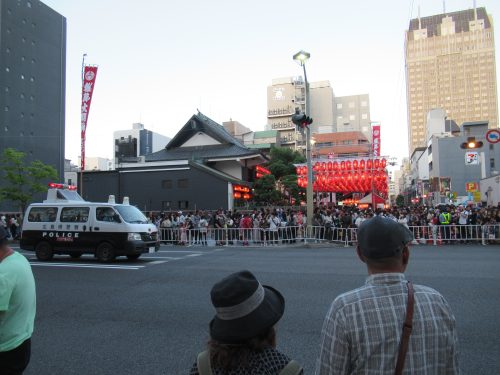
As soon as the light turned green and the cops waved us through, I weaved past the countercurrent of festival goers as I made my way north to Shintenchi Park, where the once-empty festival site was now saturated with locals and tourists alike. Avoiding the central dance hub wasn’t a solution either, as the surrounding refreshment tents were also densely inhabited by giddy and inebriated festival goers relishing the show. In spite of how crowded this place was, it’s actually not uncommon to spot familiar faces here because everyone who comes downtown usually attends the Obon dance here at some point over the weekend. Whether one is wearing a yukata or not, dancing around the yagura with complete strangers usually ends up being a blast, and with enough trial and error, anyone can get the steps down pat.
Entertainment for the night cycled between the Bon Odori and performers singing atop the yagura, and what performer was more long-awaited than the renowned Issei Minami himself? Mr. Minami mostly sang songs about nightlife in Hiroshima’s main entertainment district, and while they were oldies, they were certainly goodies. In addition to the above pieces, the audience also adored his rendition of the Hiroshima Carp theme song, chanting along with him at specific parts. If there was any one song that captivated everyone listening that night, though, it would be “Hiroshima Tengoku (Hiroshima Heaven),” which glorified locales in the city’s nightlife district that were adjacent to Shintenchi Park, such as Nagarekawa, Yagenbori, et cetera.
After his show was over and done with, I decided to call it a night, but before that, I mentally prepared to be swept up in the swarm of people circulating like blood in the heart of the city. Back on expansive Chuo-dori, there were two lanes of traffic (one going north and the other headed south), but in spite of the grandiose width of the vehicle-less road, I never felt like there was enough space for me to freely walk or take a breather. Being able to walk in the middle of the street makes it easier for festival goers to stop by any food stand to grab a final bite to eat, but if you miss the stand you want, it’s like missing your exit on the freeway and having to detour back to it. Smack dab in the middle of this pedestrian aorta was a taiko troupe mesmerizing us with their beats, like a ventricle that would charge us up before we dispersed back to our homes all over Hiroshima City.
I find the analogy to the human heart quite fitting, as Toukasan is one of few festivals that forms the lifeblood of Hiroshimarian lifestyle. Especially in 2023, Toukasan was a turning point in the year that set the mood for all subsequent festivals as every event in Hiroshima from now on (excluding the Ujina fireworks that were canceled) will be held as it normally had been. What with the G7 Summit pushing the Flower Festival back by a month and other milestones happening this year, June in Hiroshima is unusually full of festive occasions. It’s as though my wish at the Toukasan shrine came true before I even visited; the celebrations will continue at this rate for the rest of the year, and that news ought to get anybody’s blood pumping.
Written by the Joy in Hiroshima Team
